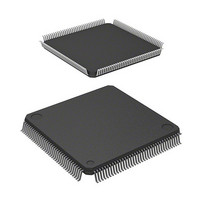R5F61665N50FPV Renesas Electronics America, R5F61665N50FPV Datasheet - Page 971

R5F61665N50FPV
Manufacturer Part Number
R5F61665N50FPV
Description
MCU FLASH 512K ROM 144-LQFP
Manufacturer
Renesas Electronics America
Series
H8® H8SX/1600r
Datasheet
1.R5F61665N50FPV.pdf
(1492 pages)
Specifications of R5F61665N50FPV
Core Processor
H8SX
Core Size
16/32-Bit
Speed
50MHz
Connectivity
EBI/EMI, I²C, IrDA, SCI, SmartCard, USB
Peripherals
DMA, LVD, POR, PWM, WDT
Number Of I /o
92
Program Memory Size
512KB (512K x 8)
Program Memory Type
FLASH
Ram Size
40K x 8
Voltage - Supply (vcc/vdd)
3 V ~ 3.6 V
Data Converters
A/D 8x10b; D/A 2x8b
Oscillator Type
External
Operating Temperature
-20°C ~ 75°C
Package / Case
144-LQFP
Lead Free Status / RoHS Status
Lead free / RoHS Compliant
Eeprom Size
-
Available stocks
Company
Part Number
Manufacturer
Quantity
Price
Company:
Part Number:
R5F61665N50FPV
Manufacturer:
Renesas Electronics America
Quantity:
10 000
- Current page: 971 of 1492
- Download datasheet (8Mb)
19.7.6
Data transmission in smart card interface mode (except in block transfer mode) is different from
that in normal serial communication interface mode in that an error signal is sampled and data can
be re-transmitted. Figure 19.29 shows the data re-transfer operation during transmission.
1. If an error signal from the receiving end is sampled after one frame of data has been
2. For the frame in which an error signal is received, the TEND bit in SSR is not set to 1. Data is
3. If no error signal is returned from the receiving end, the ERS bit in SSR is not set to 1.
4. In this case, one frame of data is determined to have been transmitted including re-transfer, and
Figure 19.31 shows a sample flowchart for transmission. All the processing steps are
automatically performed using a TXI interrupt request to activate the DTC or DMAC. In
transmission, the TEND and TDRE flags in SSR are simultaneously set to 1, thus generating a
TXI interrupt request if the TIE bit in SCR has been set to 1. This activates the DTC or DMAC by
a TXI request thus allowing transfer of transmit data if the TXI interrupt request is specified as a
source of DTC or DMAC activation beforehand. The TDRE and TEND flags are automatically
cleared to 0 at data transfer by the DTC or DMAC. If an error occurs, the SCI automatically re-
transmits the same data. During re-transmission, TEND remains as 0, thus not activating the DTC
or DMAC. Therefore, the SCI and DTC or DMAC automatically transmit the specified number of
bytes, including re-transmission in the case of error occurrence. However, the ERS flag is not
automatically cleared; the ERS flag must be cleared by previously setting the RIE bit to 1 to
enable an ERI interrupt request to be generated at error occurrence.
When transmitting/receiving data using the DTC or DMAC, be sure to set and enable the DTC or
DMAC prior to making SCI settings. For DTC or DMAC settings, see section 12, Data Transfer
Controller (DTC) and section 10, DMA Controller (DMAC).
transmitted, the ERS bit in SSR is set to 1. Here, an ERI interrupt request is generated if the
RIE bit in SCR is set to 1. Clear the ERS bit to 0 before the next parity bit is sampled.
re-transferred from TDR to TSR allowing automatic data retransmission.
the TEND bit in SSR is set to 1. Here, a TXI interrupt request is generated if the TIE bit in
SCR is set to 1. Writing transmit data to TDR starts transmission of the next data.
Data Transmission (Except in Block Transfer Mode)
Section 19 Serial Communication Interface (SCI, IrDA, CRC)
Rev. 2.00 Oct. 21, 2009 Page 937 of 1454
REJ09B0498-0200
Related parts for R5F61665N50FPV
Image
Part Number
Description
Manufacturer
Datasheet
Request
R

Part Number:
Description:
KIT STARTER FOR M16C/29
Manufacturer:
Renesas Electronics America
Datasheet:

Part Number:
Description:
KIT STARTER FOR R8C/2D
Manufacturer:
Renesas Electronics America
Datasheet:

Part Number:
Description:
R0K33062P STARTER KIT
Manufacturer:
Renesas Electronics America
Datasheet:

Part Number:
Description:
KIT STARTER FOR R8C/23 E8A
Manufacturer:
Renesas Electronics America
Datasheet:

Part Number:
Description:
KIT STARTER FOR R8C/25
Manufacturer:
Renesas Electronics America
Datasheet:

Part Number:
Description:
KIT STARTER H8S2456 SHARPE DSPLY
Manufacturer:
Renesas Electronics America
Datasheet:

Part Number:
Description:
KIT STARTER FOR R8C38C
Manufacturer:
Renesas Electronics America
Datasheet:

Part Number:
Description:
KIT STARTER FOR R8C35C
Manufacturer:
Renesas Electronics America
Datasheet:

Part Number:
Description:
KIT STARTER FOR R8CL3AC+LCD APPS
Manufacturer:
Renesas Electronics America
Datasheet:

Part Number:
Description:
KIT STARTER FOR RX610
Manufacturer:
Renesas Electronics America
Datasheet:

Part Number:
Description:
KIT STARTER FOR R32C/118
Manufacturer:
Renesas Electronics America
Datasheet:

Part Number:
Description:
KIT DEV RSK-R8C/26-29
Manufacturer:
Renesas Electronics America
Datasheet:

Part Number:
Description:
KIT STARTER FOR SH7124
Manufacturer:
Renesas Electronics America
Datasheet:

Part Number:
Description:
KIT STARTER FOR H8SX/1622
Manufacturer:
Renesas Electronics America
Datasheet:

Part Number:
Description:
KIT DEV FOR SH7203
Manufacturer:
Renesas Electronics America
Datasheet:











